#Andrea liebermann
Text


Amanda Harlech, Jean Paul Gaultier, Karl Lagerfeld, John Galliano, Oscar de la Renta, Diddy and Alek Wek for Vogue US October 1999
Photographer Annie Leibovitz
Editor Grace Coddington
Fashion Editor/Stylist Andrea Liebermann
Makeup Artist Diane Kendal
Hair Stylist Julien d'Ys
Newest Cool
#newestcool#newest cool#vogue editorial#90s vogue#2000s vogue#fashion editorial photography#archive fashion#fashion archive#fashion moodboard#modesty high fashion#fashion editorials#fashion edit#fashion editorial shoot#fashion editorial#fashion editorial magazine#fashion photograph#Amanda Harlech#jean Paul gaultier#Andrea liebermann#annie leibovitz#alek wek#John galliano#karl lagerfeld#american vogue#vogue us#vogue usa#Oscar de la Renta#diddy#p. diddy
258 notes
·
View notes
Text
POPULATION
Abounaddara
Akinbode Akinbiyi
Nevin Aladağ
Danai Anesiadou
Andreas Angelidakis
Aristide Antonas
Rasheed Araeen
Ariuntugs Tserenpil
Michel Auder
Alexandra Bachzetsis
Nairy Baghramian
Sammy Baloji
Arben Basha
Rebecca Belmore
Sokol Beqiri
Roger Bernat
Bili Bidjocka
Ross Birrell
Llambi Blido
Nomin Bold
Pavel Brăila
Geta Brătescu
Miriam Cahn
María Magdalena Campos-Pons and Neil Leonard
Vija Celmins
Banu Cennetoğlu
Panos Charalambous
Nikhil Chopra
Ciudad Abierta
Marie Cool Fabio Balducci
Anna Daučíková
Moyra Davey
Yael Davids
Agnes Denes
Manthia Diawara
Beau Dick (1955–2017)
Maria Eichhorn
Hans Eijkelboom
Bonita Ely
Theo Eshetu
Aboubakar Fofana
Peter Friedl
Guillermo Galindo
Regina José Galindo
Israel Galván, Niño de Elche, and Pedro G. Romero
Daniel García Andújar
Pélagie Gbaguidi
Apostolos Georgiou
Yervant Gianikian and Angela Ricci Lucchi
Gauri Gill
Marina Gioti
Beatriz González
Douglas Gordon
Hans Haacke
Constantinos Hadzinikolaou
Irena Haiduk
Ganesh Haloi
Anna Halprin
Dale Harding
David Harding
Maria Hassabi
Edi Hila
Susan Hiller
Hiwa K
Olaf Holzapfel
Gordon Hookey
iQhiya
Sanja Iveković
Amar Kanwar
Romuald Karmakar
Andreas Ragnar Kassapis
Kettly Noël
Bouchra Khalili
Khvay Samnang
Daniel Knorr
Katalin Ladik
Lala Rukh (1948–2017)
David Lamelas
Rick Lowe
Alvin Lucier
Ibrahim Mahama
Narimane Mari
Mata Aho Collective
Mattin
Jonas Mekas
Angela Melitopoulos
Phia Ménard
Lala Meredith-Vula
Gernot Minke
Marta Minujín
Naeem Mohaiemen
Hasan Nallbani
Joar Nango
Rosalind Nashashibi and Nashashibi/Skaer
Negros Tou Moria
Otobong Nkanga
Emeka Ogboh
Olu Oguibe
Rainer Oldendorf
Pauline Oliveros (1932–2016)
Joaquín Orellana Mejía
Christos Papoulias
Véréna Paravel and Lucien Castaing-Taylor
Benjamin Patterson (1934–2016)
Dan Peterman
Angelo Plessas
Nathan Pohio
Pope.L
Postcommodity
Prinz Gholam
R. H. Quaytman
Gerhard Richter
Abel Rodríguez
Tracey Rose
Roee Rosen
Arin Rungjang
Ben Russell
Georgia Sagri
Máret Ánne Sara
Ashley Hans Scheirl
Marilou Schultz
David Schutter
Algirdas Šeškus
Nilima Sheikh
Ahlam Shibli
Zef Shoshi
Mounira Al Solh
Annie Sprinkle and Beth Stephens
Eva Stefani
K. G. Subramanyan (1924–2016)
Vivian Suter
El Hadji Sy
Sámi Artist Group (Keviselie/Hans Ragnar Mathisen, Britta Marakatt-Labba, Synnøve Persen)
Terre Thaemlitz
Piotr Uklański
Jakob Ullmann
Antonio Vega Macotela
Cecilia Vicuña
Annie Vigier & Franck Apertet (les gens d’Uterpan)
Wang Bing
Lois Weinberger
Stanley Whitney
Elisabeth Wild
Ruth Wolf-Rehfeldt
Ulrich Wüst
Zafos Xagoraris
Sergio Zevallos
Mary Zygouri
Artur Żmijewski
Zainul Abedin (1914–1976)
Stephen Antonakos (1926–2013)
Arseny Avraamov (1886–1944)
Ernst Barlach (1870–1938)
Étienne Baudet (ca. 1638–1711)
Samuel Beckett (1906–1989)
Franz Boas (1858–1942)
Arnold Bode (1900–1977)
Lorenza Böttner (1959–1994)
Marcel Broodthaers (1924–1976)
Lucius Burckhardt (1925–2003)
Abdurrahim Buza (1905–1986)
Vlassis Caniaris (1928–2011)
Sotir Capo (1934–2012)
Cornelius Cardew (1936–1981)
Ulises Carrión (1941–1989)
Agim Çavdarbasha (1944–1999)
Chittaprosad (1915–1978)
Jani Christou (1926–1970)
Chryssa (1933–2013)
André du Colombier (1952–2003)
Gustave Courbet (1819–1877)
Christopher D’Arcangelo (1955–1979)
Bia Davou (1932–1996)
Maya Deren (1917–1961)
Ioannis Despotopoulos (1903–1992)
Thomas Dick (1877–1927)
Carl Friedrich Echtermeier (1845–1910)
Maria Ender (1897–1942)
Forough Farrokhzad (1935–1967)
Conrad Felixmüller (1897–1977)
Pavel Filonov (1883–1941)
Niccolò di Pietro Gerini (1340–1414)
Tomislav Gotovac (1937–2010)
Jacob and Wilhelm Grimm (1785–1863, 1786–1859)
Ludwig Emil Grimm (1790–1863)
Giovanni di ser Giovanni Guidi (1406–1486)
Cornelia Gurlitt (1890–1919)
Louis Gurlitt (1812–1897)
Nikos Hadjikyriakos-Ghika (1906–1994)
Oskar Hansen (1922–2005)
Sedje Hémon (1923–2011)
Theodor Heuss (1884–1963)
Karl Hofer (1878–1955)
Ralph Hotere (1931–2013)
Albert Jaern (1893–1949)
Iver Jåks (1932–2007)
Sunil Janah (1918–2012)
Alexander Kalderach (1880–1965)
Tshibumba Kanda Matulu (1947–1981 disappeared)
Leo von Klenze (1784–1864)
Kel Kodheli (1918–2006)
Louis Kolitz (1845–1914)
Spiro Kristo (1936–2011)
KSYME-CMRC (founded 1979)
Anna “Asja” Lācis (1891–1979)
Maria Lai (1919–2013)
Yves Laloy (1920–1999)
Valery Pavlovich Lamakh (1925–1978)
George Lappas (1950–2016)
Karl Leyhausen (1899–1931)
Max Liebermann (1847–1935)
George Maciunas (1931–1978)
Ernest Mancoba (1904–2002)
Oscar Masotta (1930–1979)
Mikhail Matyushin (1861–1934)
Pandi Mele (1939–2015)
Tina Modotti (1896–1942)
Benode Behari Mukherjee (1904–1980)
Krzysztof Niemczyk (1938–1994)
Ivan Peries (1921–1988)
David Perlov (1930–2003)
André Pierre (1915–2005)
Dimitris Pikionis (1887–1968)
Dmitri Prigov (1940–2007)
Hasan Reçi (1914–1980)
W. Richter
Anne Charlotte Robertson (1949–2012)
Erna Rosenstein (1913–2004)
August Wilhelm and Friedrich Schlegel (1767–1845, 1772–1829)
Bruno Schulz (1892–1942)
Scratch Orchestra (1969–1974)
Tom Seidmann-Freud (1892–1930)
Allan Sekula (1951–2013)
Baldugiin Sharav (1869–1939)
Amrita Sher-Gil (1913–1941)
Vadim Sidur (1924–1986)
August Spies (1855–1887)
Foto Stamo (1916–1989)
Gani Strazimiri (1915–1993)
Władysław Strzemiński (1893–1952)
Alina Szapocznikow (1926–1973)
Yannis Tsarouchis (1910–1989)
Antonio Vidal (1928–2013)
Albert Weisgerber (1878–1915)
Lionel Wendt (1900–1944)
Johann Joachim Winckelmann (1717–1768)
Fritz Winter (1905–1976)
Basil Wright (1907–1987)
Andrzej Wróblewski (1927–1957)
Ivan Wyschnegradsky (1893–1979)
Iannis Xenakis (1922–2001)
Androniqi Zengo Antoniu (1913–2000)
Pierre Zucca (1943–1995)
Documenta14, 2017
9 notes
·
View notes
Text
1913 – Der Sommer des Jahrhunderts von Florian Illies

Rezension 1913 – Der Sommer des Jahrhunderts
Zum Inhalt / Rezension 1913 -Der Sommer des Jahrhunderts von Florian lllies
Man könnte es auch als ein interaktives Buch bezeichnen. Florian Illies ergänzt in 1913 vorhandenes Wissen des Lesers mit anschaulichen Anekdoten und entwirrt die Beziehungen der Künstler unter– bzw. miteinander. Florian Illies flüstert dem Leser „Privates“ über bestimmte Künstler zu und der Leser lauscht voyeuristisch.
Schon die Einleitung hat mir sehr gut gefallen: Er verbindet in wenigen Sätzen den 12-jährigen Louis Armstrong mit Franz Kafka und Stalin, die nichts außer der Zeit, in welcher sie leben, wirklich etwas miteinander zu tun haben. Aber das reicht, oder vielleicht auch deswegen war ich sofort fasziniert.
Der Name Lou Andreas Salome war mir zwar im Zusammenhang mit Nietzsche bekannt, aber ich wusste nichts, außer Fakten über sie. Florian Illies zeigt, wie die Männer, ihr zu Füßen lagen. Männer, wie Friedrich Nietzsche, Franz Wedekind, Rainer Maria Rilke, Leonid Tolstoi und Richard Strauß. Das kann bestimmt nicht nur, wegen ihrer Schönheit gewesen sein. Also habe ich Lou Andreas Salome, in meine „Faszinierende Autorinnen“-Reihe, die ich im April zu rezensieren beginne, aufgenommen.
Arnold Schönberg hatte Probleme mit der Zahl 13, Aber hat er deswegen seine 12-Ton-Musik komponiert? Immerhin hat er seine Oper von „Moses und Aaron“ in „Moses und Aron“ umbenannt, weil der erste Titel 13 Buchstaben hatte. Abergläubisch, aber durchaus menschlich.
Thomas Mann wird durch den Kuraufenthalt seiner Frau Katja in Davos, zum „Zauberberg“ animiert. Unwillkürlich erinnerte ich mich sehr schwach an die Lektüre. Vielleicht eine Anregung das Buch nochmals zu lesen?
Es wäre schade, allzu viel zu verraten. Aber Else Lasker-Schüler hatte enge Bindungen zu Franz Marc, seiner Frau, Kandinsky und vielen weiteren. Oswald Spengler, Max Liebermann, Claude Monet und Picasso sind zusammen mit vielen weiteren Künstlern, die in diesem Buch die Protagonisten sind. Florian Illies schaut auch in die Schlafzimmer seiner Helden. Und eine der wichtigsten Fragen: Wer hat die Mona Lisa geklaut?
1913 - Der Sommer des Jahrhunderts macht Spaß! Spaß beim Hören! Und Spaß beim Lesen. Allerdings handelt es sich immer um Momentaufnahmen der Zeit. Der Sprecher Florian Illies plaudert ein wenig aus dem Nähkästchen.
Das Buch animiert zum Recherchieren bzw. die eigene Leseliste zu erweitern. Es macht neugierig. Was war an Lou Andreas Salome so faszinierend, dass ihr diese klugen Männer geradezu verfallen sind?
Und diese Liebe zwischen Gottfried Benn und Else Lasker-Schüler. Es lohnt sich sicherlich, die Gedichte aus dieser Zeit zu betrachten
Aber es geht nicht nur um die Menschen, sondern auch um die Werke, die in diesem Jahr entstanden sind:
Woyzeck von Georg Büchner
Die Verwandlung von Franz Kafka
Die erste Umsetzung der Blauen Pferde von Franz Marc
Die Idee zu Der Zauberberg“ von Thomas Mann
12-Ton-Musik von Arnold Schönberg
Der Untergang des Abendlands von Oswald Spengler
Eine Liebe von Swann in: Auf der Suche nach der verlorenen Zeit von Marcel Proust
Diese genannten Werke sind nur eine kleine Auswahl aus diesem Jahr der kreativen Fülle.
5/5 Punkten
Sprachliche Gestaltung
Florian Illies erzählt diese „Fakten“ leicht und locker, so als habe er gerade von einer Freundin des Künstlers ein Geheimnis erfahren, dass er uns heute erzählen darf. Ich habe ganz aufmerksam gelauscht. Der Leser oder Hörer bringt oft ein schulisches Grundwissen über diesen Künstler mit. Genau dieses Wissen erweckt Florian Illies zum Leben. Ein wenig frivol, ein bisschen voyeuristisch, aber vor allem ist es amüsant. Es sind Anekdoten. Durch diese Vorgehensweise macht Florian Illies, aber nicht nur die Künstler, sondern auch deren Werke lebendig.
In zwölf Kapiteln, für jeden Monat im Jahr 1913 erzählt Florian Illies, was es kulturell zu erwähnen lohnt. Am Ende des Buches zitiert der Autor in einer Auswahlbibliografie, Werke denen er wichtige Hinweise verdankt. Also wer Appetit auf mehr hat, nehme sich diese Liste als Leseliste. Ab und zu hätte ich mir gewünscht, Florian Illies wäre länger bei einem Thema geblieben.
5/5 Punkten
Cover und äußere Erscheinung
Zur Vita Florian Illies
Der Einband ist schön gestaltet. Es zeigt wohl Frauen, die auf Wiesen wandeln. Passt!
4/5 Punkten
Das Hörbuch
Das Hörbuch gibt es zur Zeit (13.03.2019) bei audible herabgesetzt ca. zum halben Preis.
Playlist auf Youtube
https://www.youtube.com/watch?v=phqeU2LMu_w&list=PL2G2jR9rOAY0zLERueOFWlY9HItRXPqOk
Fazit
1913 ist das letzte Jahr der guten alten Zeit. Es ist das letzte Jahr einer langen Friedensperiode. Bei dem Buch 1913 – Ein Jahrhundertsommer handelt es sich um ein stark kulturell ausgerichtetes Buch. Auf dieses kulturelle Füllhorn folgt das Zeitalter der Katastrophen.
Mir hat das Buch sehr gut gefallen, die Verbindungen der Künstler untereinander waren mir oft nicht bekannt. Somit entwickelten sich aus kleinen Skizzen, farbenfrohe Charaktere. Ich hätte mir manchmal gewünscht, die Passage zu manchen Themen wäre länger gewesen, deswegen ziehe ich insgesamt 0,5 Punkte ab.
Aber es gibt ja noch den zweiten Teil: 1913 - Was ich unbedingt noch erzählen wollte
Ich vergebe insgesamt 4,5/5 Punkten.
@Liebe Nicole, vielen Dank für „1913 – der Sommer des Jahrhunderts“, auch wenn ich einige Jahre brauchte, das Buch endlich zu lesen.
Weiter zu ...
Rezension Fahrenheit 451 Ray Bradbury
"Einfach Mensch sein" von Sy Montgomery
Read the full article
#1913#1913-DerSommerdesJahrhunderts#DerSommerdesJahrhunderts#ElseLasker-Schüler#FlorianIllies#FranzMarc#FriedrichNietzsche#Hörbuch#LouAndreasSalome#Sachbücher
0 notes
Text
10 of the best galleries in Berlin | Travel
New Post has been published on https://factpatrol.com/2017/05/04/10-of-the-best-galleries-in-berlin-travel/
10 of the best galleries in Berlin | Travel
C/O Berlin

Freeze frame … the C/O Gallery focuses on photography. Photograph: Anita Bugge/WireImage
The C/O Gallery is in the old royal post office (Postfuhramt); a stunning, elaborate brick building dating from 1881, which holds pride of place on a prominent corner of Oranienburgerstrasse. The focus is on photography; supporting young, up-and-coming artists as well as attracting some of the biggest names in the business – Robert Mappelthorpe, Peter Lindbergh and Annie Leibovitz all recently had retrospectives there. It also hosts an impressive schedule of workshops, lectures and events – people often remark upon C/O’s warm atmosphere – even though it’s a sprawling gallery, with more than 2,000sq metres of space. However, there are rumours that this particular space has a shelf life – regrettably, it’s soon to be renovated and become luxury apartments, as with so many of Berlin’s beautiful old buildings. All the more reason then to experience it now.
• Oranienburgerstrasse 35/36, Mitte, +49 30 2844 4160, co-berlin.info. Adults €10, concessions €5
Berlinische Galerie

Photograph: Alamy
An artists’ favourite, often coming top in opinion polls – when the artists vote among themselves. It is a renovated former glass warehouse, with plenty of light, white walls, white floors and cleverly designed, criss-crossing staircases. It offers a steady flow of new exhibitions, including recent shows from fashion anti-hero Nan Goldin and a retrospective of the Berlin-born Arno Fischer. The gallery also has an amazing permanent collection of work produced by Berlin artists since 1870 – which covers extremely tumultuous and varied periods in history: Expressionism, Berlin Dada, Art in the Nazi era, the New Beginning after 1945 and Positions of the 1950s. There will be Berlin artists you won’t have heard of before your visit, but won’t forget after seeing, such as Max Liebermann, Raoul Hausmann, Otto Bartning and Naum Gabo.
• Alte Jakobstrasse 124-128, Kreuzberg, +49 30 7890 2600 berlinischegalerie.de. Adults €8, concessions €5, every first Monday of the month €4, free for visitors under 18
Hamburger Bahnhof – Museum für Gegenwart

Photograph: Alamy
You’ll find the gleaming white Hamburger Bahnhof in the beautiful former main train station built in 1847 – now all skylights, white walls and polished wooden floors. Its central collection is from Berlin entrepreneur Dr Erich Marx, including a vast collection of art, from Beuys and Rauschenberg to Lichtenstein and Warhol (whose iconic Mao has a permanent home here). The National Gallery also has a permanent collection here, focussing on 1960 to the present (so expect some brilliant photography, painting and video art from the likes of Andreas Gursky, Bill Viola and Marcel Odenbach). The Marzona collection is also fascinating, and a shining example of conceptual and minimal art at its best – highlights include Ronald Bladen, Giuseppe Penone and Mario Merz).
• Invalidenstrasse 50-51, Mitte, +49 30 3978 3411, hamburgerbahnhof.de. Adults €12, concessions €6
Pool Gallery
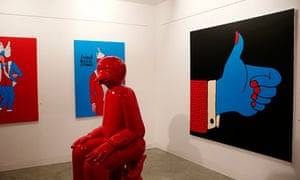
Photograph:
JB. Magazine on Flickr/
Some rights reserved
The Pool Gallery has plenty of typically cool Mitte stamps: a shopfront, white walls, and almost-scarily hip staff. Curator (and artist-cum-musician) Ruby Anemic’s feeling for street culture, young, modern art and cool photography makes the Pool Gallery well worth a visit. Whether it’s a light installation, painting, graphic design or photography, the exhibitions are always fresh and zeitgeisty. Past shows have included works from Henrik Vibskov, Alex Flach, Benjy Russell and Mercedes Helnwein. Changes are afoot: their team is joining forces with Schlechtriem Brothers (also in Mitte) to create a new gallery in both spaces called DITTRICH & SCHLECHTRIEM, which will be opening in September 2011.
• Tucholskystrasse 38, Mitte, +49 30 2434 2462, pool-gallery.com. Admission free
Sammlung Boros Collection
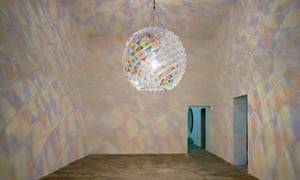
Photograph: Noshe
The Sammlung Boros Collection is shrouded in a veneer of secrecy. You can only view it on the weekends, by appointment. As a result, going to an art gallery has never felt so thrilling. Not to mention the fact this vast contemporary modern art collection is housed in an imposing second world war bunker. It was built in 1942 as a bomb shelter, was later used as a prison, then a storage depot for bananas, and latterly it was a club famed for its S&M fetish parties – until Christian Boros and his family bought it. As for the actual art collection, it is quite remarkable: currently it has 159 works from international artists using sculpture, video and installation from Wolfgang Tillmans to Tracey Emin.
• Reinhardtstrasse 20, Mitte, +49 30 2759 4065, sammlung-boros.de. Guided tours only: €10
me Collectors Room
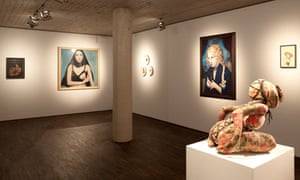
Photograph: Jana Ebert
The me Collectors Room houses the personal collection of Thomas Olbricht, an esteemed art collector, chemist, and endocrinologist (a somewhat unique combination), who, over the past 25 years, has succeeded in creating one of the most extensive private collections in Europe. The diversity of artistic genre, period, and medium is extraordinary, with works from the 16th century to the present day. Expect to see a selection of macabre works (often featuring skulls, stuffed animals, and dark, ominous religious or tribal pieces) curated besides works exploring sexual or erotic themes, such as a photography series depicting Japan’s sex industry.
• Auguststrasse 68, Mitte, +49 30 8600 8510, me-berlin.com. Adults €6, concessions €4, group tickets €4 (for groups above 10), free for visitors under 18
KW Institute for Contemporary Art

Photograph: Petrit Halilaj
The KW Institute for Contemporary Art combines an ambitious artistic programme that includes workshops, exhibitions, and onsite artist studios, with regular events, screenings, and performances. Viewing itself as a “laboratory for communicating and advancing contemporary cultural developments in Germany”, it launched one of Berlin’s most significant artistic events, the Berlin Biennale, in 1996. It’s huge, too – with four floors, a large ground floor space, and a quaint courtyard – so give yourself plenty of time to explore and reward yourself with a drink afterwards.
• Auguststrasse 69, Mitte, +49 30 243 4590, kw-berlin.de. Adults €6, concessions €4, groups of 10 or more: €5, €3 concessions, Thursday evening ticket (7-9 pm) €4
Carlier Gebauer
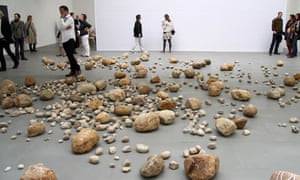
Photograph:
Michael Türschmann on Flickr/
Some rights reserved
Founded in 1991, this is one of Berlin’s most significant independent contemporary art galleries, partly due to its longevity, but mainly due to its high-calibre exhibitions. Located among Berlin’s gallery district in the Kochstrasse area, it represents a stellar cast of emerging and established artists, such as video artist Rosa Barba and installation artist Aernout Mik. The 600sq metre gallery, made up of three “white box” rooms, can exhibit three solo shows at a time, as well as showcasing the latest video works in the projection area (cinemathek).
• Markgrafenstrasse 67, Mitte, +49 30 2400 8630, carliergebauer.com. Admission free
Johann König
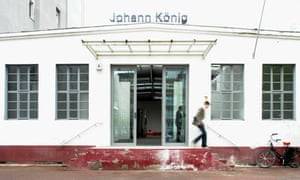
Photograph: Gregor Hose
Featured in Art Review’s Power 100 – a guide to the general trends, networks and forces that shape the art world – Johann König is situated in between the Neue Nationalgalerie and the gallery district in Kochstrasse, making for a great stopover between the two. Detached from its neighbouring buildings and nestled away from Dessauer Strasse, the Johann König gallery is a contemporary, white-walled space that may seem subtle and unassuming at first but certainly isn’t: expect a dramatic range of contemporary mediums, from sculpture and painting to large-scale multimedia installations.
• Dessauerstrasse 6-7, Mitte, +49 30 2610 3080, johannkoenig.de. Admission free
Galerie Open

Photograph: Zachary Fabri
Founded in 2008, the gallery programme at Open represents young, unknown contemporary artists, primarily from Berlin and New York. Located near Moritzplatz in Kreuzberg, this gallery could well go on to contend with the “big dogs” of the gallery district not too far from here. Featuring a main ground floor gallery space, an over-looking mezzanine, and a basement space, the viewer can explore three levels of diverse contemporary art that changes with each new exhibition. A visit during the summer is recommended: Alexandra Rockelmann (the gallery owner) hands over her gallery space to a young curator and a selection of emerging artists during the seasonal hiatus.
• Legiendamm 18-20 (Engelbecken), Kreuzberg, +49 30 2758 2810. galerie-open.net. Admission free
• Liz McGrath and Jack Howard blog at Bang Bang Berlin. The new Bang Bang Berlin gallery is at Chorienrstraße 34.
Source link
0 notes
Text


Kate Moss & Diddy for Vogue US October 1999
Photographer Annie Leibovitz
Fashion Editor Grace Coddington
Stylist Andrea Liebermann
Makeup Artist Diane Kendal
Hair Stylists Julien d'Ys & Mark Daddy
Newest Cool
#newestcool#newest cool#90s Kate moss#Kate moss#p diddy#p. diddy#diddy#vogue usa#vogue us#vogue editorial#vogue magazine#vogue cover#90s vogue#annie leibovitz#grace coddington#Andrea liebermann#90s editorial#90s fashion#90s magazine#90s vogue magazine#love diddy#pdiddy#scarface#scarface the movie#alpacino#al pacino#Tony montana
47 notes
·
View notes
Text

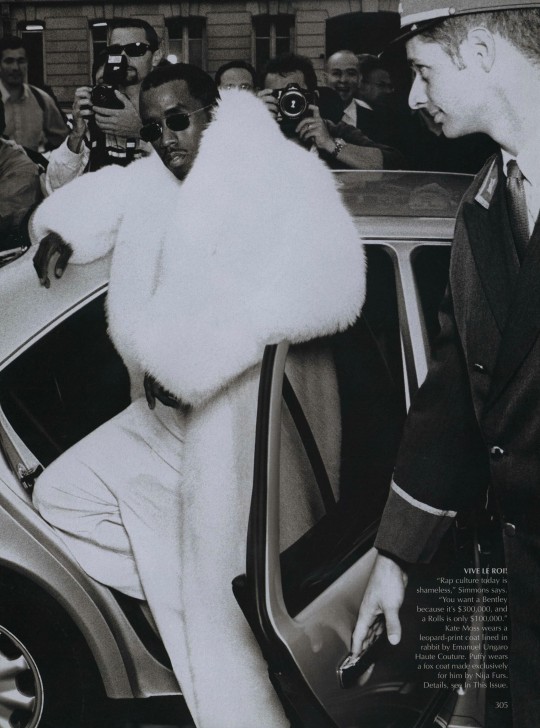
Kate Moss & Diddy for Vogue US October 1999
Photographer Annie Leibovitz
Fashion Editor Grace Coddington
Fashion Stylist Andrea Liebermann
Makeup Diane Kendal
Hair Julien d'Ys & Mark Daddy
Newest Cool
#newestcool#newest cool#90s runway#90s look#90s model#90s editorial#2000s fashion looks#2000s style#2000s aesthetic#2000s model#2000s look#2000s outfit#kate moss#kate moss agency#kate moss style#kate moss 90s#kate moss is boss#kate moss forever#kate moss daily#90s kate moss#vogue magazine#vogue editorial#vogue cover#90s vogue#fashion editorials#fashion edit#fashion editorial shoot#fashion editorial#fashion photograph#fashion editorial magazine
38 notes
·
View notes